
Goju-kalis 剛柔カーリー Goju-ryu Influenced Filipino Martial Arts is managed by the Kokusai Goju-kalis Kenkyukai 国際剛柔 カーリー研究会 the International Goju-ryu Influenced Filipino Martial Arts Research Society which is a department of the Sekai Kushindo Kobujutsu Kenkyukai 世界空神道古武術研究会 the World
Kushido Classical Martial Art Research Society.
Goju-kalis is a
companion art to Goju-kenpo, the traditional Ceberano-ha Goju-ryu karatejutsu method and Goju-kobujutsu, the Goju-ryu influenced method of Clasical Japanese Martial Arts.
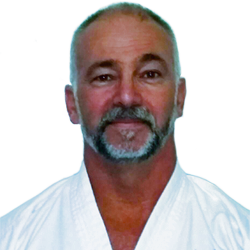
Chris CLAYTON Kyoushi is the technical leader for Goju-kalis under Ceberano Hanshi's direction
Chris CLAYTON Shihan
Goju-kalis was developed from the methods of Ceberano hanshi's Filipino Elusive Warrior skill set to provide Goju-ryu Karateka 剛柔流空手家 Goju-ryu Karate
Practioners with a
broader, deeper view of the martial arts in order to enhance the skills that
they have acquired through their karatejutsu training.
Goju-kalis contains many of the technical features that are found in traditional Filipino Martial Art traditions as well as some inovations introduced by Ceberano Hanshi.
Karateka
may begin training in Goju-kalis once they have achieved proficiency at the Karatejutsu Shodan 空手術初段 Black Belt 1st Dan level; actually students may begin training before
this time with the permission of their Dojocho 道場長 Dojo Leader, however, they will not be able to be formally
certified at a senior level in Goju-kalis until they have been certified as Yudansha有段者Certified
Black Belt holder in
Goju-ryu Karatejutsu unless otherwise authorised by the headmaster.
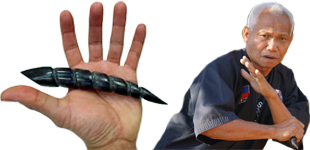
Goju-kalis is a comprehensive expression of Filipino Martial Arts including armed and unarmed methods. The weapons component includes the following methods:
1. The Baston, (Single and Double) which is Spanish and Filipino for
"cane," the ubiquitous Kali Stick is one of the primary weapons
of Goju-kalis and most other Filipino Martial Arts. It is also known
as yantok, olisi, palo, pamalo, garrote, caña, cane, arnis stick,
eskrima stick or simply, stick.
2. The Karambit, the ubiquitous rice harvesting knife of the South East Asian
Archipelagos. Used like all weapons as a simple extension of the hand
3. The Dulo Dulo "Two Points" or as Olisi Palad "Palm Stick" which is used in a similar
way to the karmbit except that it has no edge.
In Japan it is known as Yawara or Yawara Stick, as Shujo "Palm Stick" or as
Kongou "Thunderbolt." In China it is known as Jingang Chu "Thunderbolt Baton"
and in South Asia it is known as Vajra "Thunderbolt."
4. The Goju-kalis Hawakan or side-handle Baton is a little different to the
common Hawakan as it has three "Points," one at each end of the long
shaft and a third on the handle where it extends through the long shaft,
making it a usefull too for attacking vital points of the body. In Goju-kalis the
Hawakan is used singularly rather than paired as in Okwinawan Kobudo.
In China it is known as Guai "Crutch," on Okinawa it is known as Tonfa,
Tongfa or Tuifa and in Japan as Kai or Tonfa and in Malaysia as Mai Sok San.
5. The Tungkod or "Crooked Cane" walking stick features in Arcanis "the art of the Cane."
The cane flows much in the same way as the Baston described above.
The Tungkod is known as Shujo "Hand Cane" or Tsutekki (Romaji for "Stick") in Japanese.
6. The Nobby Nakka is a new weapon developed by Ceberano Hanshi and his senior
Goju-kalis practitioners it consists of a weighted chord that loops around the wrist.
The Nobby Nakka is much like the traditional Japanese weapon called Kusari-fundo
"Weighted Chain." In Japanese it could well be called Tsuru-fundo "Weighted Chord."
The Goju-kalis team developed a companion weapon called Nobby Chakku which is
a chord like the Nobby Nakka but weighted at both ends. Both of these weapons are
used in a manner similar to the Okinawan weapon Nunchaku "Rice Flail".
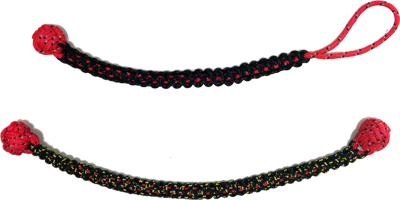
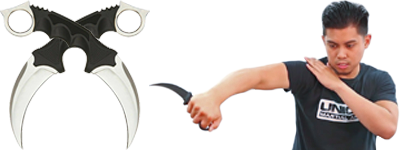

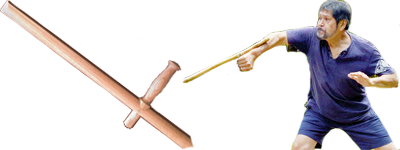
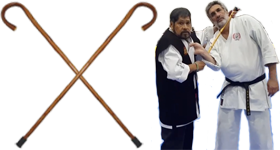
As
students’ progress through their Goju-kalis training they will be qualify for progress
awards . The Goju-kalis levels are:
Junior Levels
| Dayan Puti | White | Novice |
| Dayan Dulas | Yellow | Beginner |
| Dayan Dulas | Green | Intermediate Practitioner |
| Dayan Kayumangi | Brown | Advanced Practitioner |
Senior Levels
| Lakan Isa | Level 1 Guro | Non Teaching |
| Lakan Dalawa | Level 2 Guro | Non Teaching |
| Lakan Tatlo | Level 3 Guro | Teacher |
| Lakan Apat | Level 4 Guro Maestro | Teacher |
| Lakan Lima | Level 5 Guro Maestro | Teacher |
| Lakan Amin | Level 6 Guro Maestro | Teacher |
| Lakan Pito | Level 7 Guro Maestro | Senior Teacher |
| Lakan Walo | Level 8 Guro Maestro | Master Teacher |
| Lakan Siyam | Level 9 Guro Maestro | Master Teacher |
| Lakan Sampu | Level 10 Pangulong Guro | Grand Master |
created with
Website Builder Software .